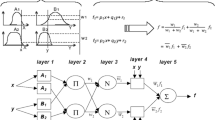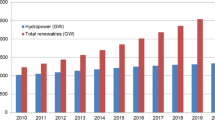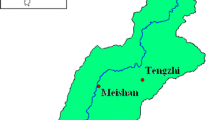Abstract
The global learning method is widely used to train data-driven models for hydrological forecasting. The drawback of global models is that a long data record is required and the model is not easily adapted once it is trained. This study investigated the local learning approach applied in the dynamic evolving neural-fuzzy inference system (DENFIS) to provide 5-lead-day water level forecasts for the Mekong River. The local learning method focuses on the relationship between input and output variables at the most recent state. The results obtained from DENFIS were found to be better than results obtained from adaptive neuro-fuzzy inference system, which uses global learning approach, and the unified river basin simulator model. Local learning provides continuous model updating, and the results obtained in this study show that local learning is a promising tool for water level forecasting in real-time flood warning applications.
Similar content being viewed by others
References
Badrzadeh H, Sarukkalige R, Jayawardena AW (2015) Hourly runoff forecasting for flood risk management: application of various computational intelligence models. J Hydrol 529:1633–1643
Bazartseren B, Hildebrandt G, Holz KP (2003) Short-term water level prediction using neural networks and neuro-fuzzy approach. Neurocomputing 55(3–4):439–450
Bowden GJ, Dandy GC, Maier HR (2005) Input determination for neural network models in water resources applications. Part 1. Background and methodology. J Hydrol 301:75–92
Bowden GJ, Maier HR et al (2005) Input determination for neural network models in water resources applications. Part 2. Case study: forecasting salinity in a river. J Hydrol 301:93–107
Bowden GJ, Maier HR, Dandy GC (2012) Real-time deployment of artificial neural network forecasting models: understanding the range of applicability. Water Resour Res. doi:10.1029/2012WR011984
Carrol DG (2007) URBS manual—a rainfall runoff routing model for flood forecasting and design
Chang FJ, Chiang YM, Ho YH (2015) Multistep-ahead flood forecasts by neuro-fuzzy networks with effective rainfall-run-off patterns. J Flood Risk Manag 8(3):224–236
Chang FJ, Tsai MJ (2016) A nonlinear spatio-temporal lumping of radar rainfall for modeling multi-step-ahead inflow forecasts by data-driven techniques. J Hydrol 535:256–269
Chen SH, Lin YH, Chang LC, Chang FJ (2006) The strategy of building a flood forecast model by neuro-fuzzy network. Hydrol Process 20(7):1525–1540
Chiu SL (1994) Fuzzy model identification based on cluster estimation. J Intell Fuzzy Syst 2:267–278
Gautam DK, Holz KP, Meyer Z (2001) Real-time forecasting of water levels using adaptive neuro-fuzzy systems. Arch Hydroeng Environ Mech 48(4):3–21
Goodwin GC, Sin KS (1984) Adaptive filtering prediction and control. Prentice-Hall, Upper Saddle River
Hong YST, White PA (2009) Hydrological modeling using a dynamic neuro-fuzzy system with on-line and local learning algorithm. Adv Water Resour 32(1):110–119
Jang J-SR (1993) ANFIS: adaptive-network-based fuzzy inference system. IEEE Trans Syst Man Cybern 23(3):665–685
Jayawardena AW, Perera EDP, Zhu B (2014) A comparative study of fuzzy logic systems approach for river discharge prediction. J Hydrol 514:85–101
Kasabov NK, Song Q (2002) DENFIS: dynamic evolving neural-fuzzy inference system and its application for time-series prediction. IEEE Trans Fuzzy Syst 10(2):144–154
Kitanidis PK, Bras RL (1980) Real-time forecasting with a conceptual hydrologic model 2. Applications and results. Water Resour Res 16(6):1034–1044
Nash JE, Sutcliffe JV (1970) River flow forecasting through conceptual models part I—a discussion of principles. J Hydrol 10(3):282–290
Nayak PC, Sudheer KP, Rangan DM, Ramasastri KS (2005) Short-term flood forecasting with a neurofuzzy model. Water Resour Res 41:1–16
Nguyen PKT, Chua LHC (2012) The data-driven approach as an operational real-time flood forecasting model. Hydrol Process 26(19):2878–2893
Nguyen PKT, Chua LHC (2014) Flood forecasting in large rivers with data driven models. Nat Hazards 71(1):767–784
Ooyen AV, Nienhuis B (1992) Improving the convergence of the back-propagation algorithm. Neural Networks 5(3):465–471
Rajurkar MP, Kothyari UC, Chaube UC (2002) Artificial neural networks for daily rainfall-runoff modelling. Hydrol Sci J 47(6):865–878
Rezaeianzadeh M, Tabari H, Yazdi AA (2014) Flood flow forecasting using ANN, ANFIS and regression models. Neural Comput Appl 25(1):25–37
Shrestha RR, Theobald S, Nestmann F (2005) Simulation of flood flow in a river system using artificial neural networks. Hydrol Earth Syst Sci 9(4):313–321
Takagi T, Sugeno M (1985) Fuzzy identification of systems and its applications to modeling and control. IEEE Trans Syst Man Cybern 15(1):116–132
Talei A, Chua LHC, Quek C, Jansson P-E (2013) Runoff forecasting using a Takagi–Sugeno neuro-fuzzy model with online learning. J Hydrol. doi:10.1016/j.jhydrol.2013.02.022
Young CC, Liu WC, Chung CE (2015) Genetic algorithm and fuzzy neural networks combined with the hydrological modeling system for forecasting watershed runoff discharge. Neural Comput Appl 26(7):1631–1643
Author information
Authors and Affiliations
Corresponding author
Ethics declarations
Conflict of interest
The authors declare that they have no conflict of interest.
Rights and permissions
About this article
Cite this article
Nguyen, P.KT., Chua, L.HC., Talei, A. et al. Water level forecasting using neuro-fuzzy models with local learning. Neural Comput & Applic 30, 1877–1887 (2018). https://doi.org/10.1007/s00521-016-2803-9
Received:
Accepted:
Published:
Issue Date:
DOI: https://doi.org/10.1007/s00521-016-2803-9












